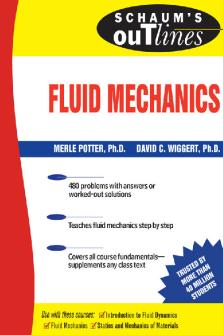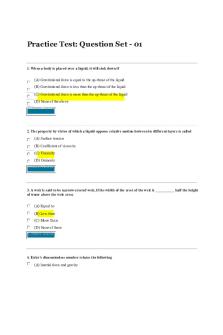ETS1 Fluid Mechanics Introduction Lecture slides PDF

| Title | ETS1 Fluid Mechanics Introduction Lecture slides |
|---|---|
| Course | Engineering Systems Design 1 |
| Institution | University of Melbourne |
| Pages | 15 |
| File Size | 1.1 MB |
| File Type | |
| Total Downloads | 37 |
| Total Views | 137 |
Summary
These are the lecture slides for the fluid mechanics section. This section is actually the area where you can do really well....
Description
Faculty of Engineering and Information Technology
Engineering: Technology and Society Introduction to Fluid Mechanics Learning Objectives: • • • • •
Introduction to Design Problem Basic concepts of fluid properties Common units Introduce hydrostatic pressure Flow Instabilities
Design Project: Questions Design in Sub-Systems!!!!
WATER TOWER
Distribution Sub-System
Pump Sub-System
Water Storage Tank
Tap
Particle Filter
Tap
IIM Membrane Unit
Pump
100 m
Start with: What are the key parameters to describe water flowing in a pipe?
Questions – Section 1 What is the volume of water that is processed every day? How long should the process take? What is the flow rate in section 1? Lecture – Fluid Mechanics Introduction
Section 2 How much water does the water tower need to hold? What it the flow rate and pressure required at each tap? What pipe is the diameter? Are all diameters the same? 2
Engineering: Technology and Society
Pressure – what is it? •
Pressure is the force over an area applied to an object in a direction perpendicular to the surface.. 1m2 surface area
Force (Newtons)
• Pascal (Pa) is the SI unit of pressure: – 1Pa = 1N / 1m2
• Consider pressure due to force from gravity: •
kg Force (Newtons = kg.m/s2)
Pa = N / m2 = kg . m/s2 / m2 = kg / (m.s2)
1m2 surface area Lecture – Fluid Mechanics Introduction
3
Engineering: Technology and Society
Other units of pressure • Pressure is measured in: – N/m2 = Pascal (Pa) – pounds per square inch (psi) – millimeters of Mercury (mmHg) – atmospheres (atm)
Pressure at ambient conditions 1 atm 101325 Pa or 101.325 kPa 14.7 PSI 760 mmHg
Lecture – Fluid Mechanics Introduction
4
Engineering: Technology and Society
Atmospheric pressure http://www.baywx.com.au
• Atmospheric pressure = Barometric pressure = Pressure at sea-level – 1 atm – 101325 Pa or 101.325 kPa – 14.7 psi – 760 mmHg
1hPa = 1hectopascal = 100Pa
Pressure in most airplanes
Atmosphere
8,000 ft = 564 mm Hg
Boeing 787 Dreamline – 6,000 ft = 609 mm Hg Lecture – Fluid Mechanics Introduction
5
Engineering: Technology and Society
How to measure Pressure (Gauge Pressure)
• Gauge pressure is the pressure relative to the local atmospheric or ambient pressure. • Recall atmospheric pressure: – 1 atm = 101.325 kPa = 14.7 psi
Pressure Gauge on Rig
• What does a gauge pressure of 30 psi mean? – Absolute pressure in tyre is 44.7 psi (= 14.7 + 30) psi Lecture – Fluid Mechanics Introduction
6
Engineering: Technology and Society
Pressure in an Open Container • In a liquid, there is additional pressure from the weight of the liquid above it.
r – liquid density, kg/m3 g – gravity = 9.8 m/s2 H – height, m •
Liquid
H
Pa = N / m2 = kg . m/s2 / m2 = kg / (m.s2) = r . m/s2 . m = r.g.H
Lecture – Fluid Mechanics Introduction
7
Engineering: Technology and Society
Pressure in an Open Container • In a liquid, there is additional pressure from the weight of the liquid above it.
Liquid
∆𝑝 = 𝑝! − 𝑝"#$ = 𝜌gH H1
𝑝! = 𝑝"#$ + 𝜌g(𝐻% + 𝐻! ) H2
Lecture – Fluid Mechanics Introduction
8
Engineering: Technology and Society
What characterises a fluid? • A fluid is a substance that continually deforms (flows) under an applied shear stress. – “fluid” is often used as a synonym for “liquid”
• Density - r (kg/m3) – mass per unit volume
• Viscosity - µ (Pa.s) – measure of the resistance of a fluid which is being deformed by either shear stress or tensile stress. – for fluids, viscosity can be thought of as “thickness” Lecture – Fluid Mechanics Introduction
9
Engineering: Technology and Society
Density – what is it? • Density - r (kg/m3) – the density of a material is defined as its mass per unit volume • Densities of some common materials: Material
Density (kg/m3)
Density (g/ml)
Fresh Water
1000
1
Salt Water
1030
1.030
Glycerol
1261
1.261
Iron
7874
7.874
Lecture – Fluid Mechanics Introduction
10
Engineering: Technology and Society
Viscosity • Dynamic Viscosities of some common fluids: Liquid (at 25 °C)
Viscosity (Pa.s)
Water
0.000894
Blood
0.003
Sulfuric acid
0.0242
Olive oil
0.081
“Blood is thicker than water...” Related to pourability
• Important aspects of viscosity: – Viscosity decreases as temperature increases. – Fluid Flow has friction, a more viscous fluid has more friction. – This friction can lead to energy dissipation and flow instabilities Lecture – Fluid Mechanics Introduction
11
Engineering: Technology and Society
Faculty of Engineering and Information Technology
Engineering: Technology and Society Introduction to Fluid Mechanics: Consultation Examples Learning Objectives: • • • •
Basic concepts of fluid properties Common units Introduce hydrostatic pressure Flow Instabilities
Pressure in an Open Container
Liquid
∆𝑝 = 𝑝! − 𝑝"#$ = 𝜌gH 𝑝! = 𝑝"#$ + 𝜌gH 𝑝! =? ? ? ? ? 𝐻 = ????? H1 = 4 H5 = 12 H2 = 10
H3 = 15 H4 = 7
Lecture – Fluid Mechanics Introduction
Engineering: Technology and Society
Viscosity • Viscosity Units • The SI unit for dynamic viscosity: – – – –
pascal second, Pa.s. 1 Pa.s = 10 Poise 100 centi-Poise = 1 poise (P) So 1 Pa.s = ? Centi-Poise
Liquid (at 25°C)
Viscosity (Pa.s)
Viscosity (mPa.s)
Water
0.000894
.894
Blood
0.003
3
Sulfuric acid
0.0242
24.2
Olive oil
0.081
81
Lecture – Fluid Mechanics Introduction
15
Viscosity (Poise)
Viscosity (Centi-Poise)
Engineering: Technology and Society
Flow Instabilities
Lecture – Fluid Mechanics Introduction
16
Engineering: Technology and Society...
Similar Free PDFs

Introduction to Fluid Mechanics
- 321 Pages

Fluid Mechanics lecture notes
- 133 Pages

Fluid Mechanics, Lecture 4
- 27 Pages

Lecture 1: Introduction - Slides
- 14 Pages

Fluid Mechanics
- 260 Pages

Fluid Mechanics
- 796 Pages

Fluid Mechanics
- 8 Pages

Fay - Introduction to Fluid Mechanics-1
- 232 Pages

fluid mechanics
- 8 Pages

Fluid mechanics history essay
- 16 Pages

Nestle - Summary Fluid Mechanics
- 3 Pages

Fluid Mechanics 2 MCQ
- 109 Pages
Popular Institutions
- Tinajero National High School - Annex
- Politeknik Caltex Riau
- Yokohama City University
- SGT University
- University of Al-Qadisiyah
- Divine Word College of Vigan
- Techniek College Rotterdam
- Universidade de Santiago
- Universiti Teknologi MARA Cawangan Johor Kampus Pasir Gudang
- Poltekkes Kemenkes Yogyakarta
- Baguio City National High School
- Colegio san marcos
- preparatoria uno
- Centro de Bachillerato Tecnológico Industrial y de Servicios No. 107
- Dalian Maritime University
- Quang Trung Secondary School
- Colegio Tecnológico en Informática
- Corporación Regional de Educación Superior
- Grupo CEDVA
- Dar Al Uloom University
- Centro de Estudios Preuniversitarios de la Universidad Nacional de Ingeniería
- 上智大学
- Aakash International School, Nuna Majara
- San Felipe Neri Catholic School
- Kang Chiao International School - New Taipei City
- Misamis Occidental National High School
- Institución Educativa Escuela Normal Juan Ladrilleros
- Kolehiyo ng Pantukan
- Batanes State College
- Instituto Continental
- Sekolah Menengah Kejuruan Kesehatan Kaltara (Tarakan)
- Colegio de La Inmaculada Concepcion - Cebu



